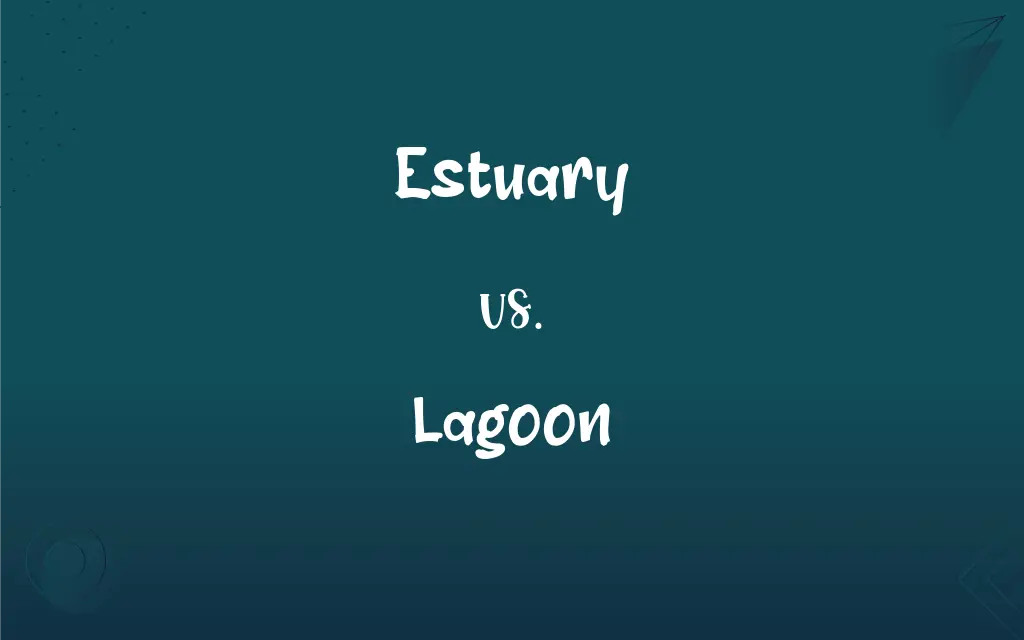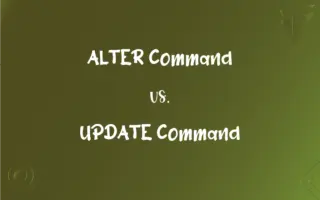Estuary vs. Lagoon: What's the Difference?
Edited by Aimie Carlson || By Janet White || Published on February 29, 2024
An estuary is a partially enclosed coastal body of water where freshwater mixes with seawater, while a lagoon is a shallow body of water separated from a larger sea by barriers.

Key Differences
Estuaries form at river mouths where the river meets the sea, mixing fresh and saltwater. Lagoons are often separated from the open sea by sandbars, coral reefs, or barrier islands.
In estuaries, freshwater from rivers dilutes the seawater, creating a unique brackish environment. Lagoons tend to have more stable salinity levels, influenced primarily by the sea but protected from its full force.
Estuaries are dynamic environments with tidal action influencing their ecosystems. Lagoons, being more isolated, have less tidal influence and often calmer waters.
The biodiversity in estuaries is high, supporting various species adapted to brackish water. Lagoons, while also biologically diverse, may have ecosystems more similar to either freshwater or marine environments, depending on their salinity.
Estuaries play a crucial role in the life cycles of many marine species, serving as nurseries. Lagoons can serve similar roles but are often more recreational in use, known for their scenic beauty and tranquility.
ADVERTISEMENT
Comparison Chart
Formation
Where a river meets the sea, mixing freshwater and saltwater.
Separated from the sea by barriers like sandbars or coral reefs.
Water Type
Brackish water, a mix of fresh and saltwater.
Generally stable salinity, more influenced by the sea.
Tidal Influence
Strong tidal action due to connection with the open sea.
Limited tidal influence due to separation from the open sea.
Biodiversity
High, with species adapted to brackish environments.
Varied, may lean towards freshwater or marine ecosystems.
Primary Roles
Crucial for marine life cycles, serving as nurseries.
Often recreational, known for beauty and leisure activities.
ADVERTISEMENT
Estuary and Lagoon Definitions
Estuary
An estuary serves as a transitional zone between river environments and maritime ecosystems.
The estuary provided a critical habitat for both freshwater and saltwater species.
Lagoon
Can have varying levels of salinity, from brackish to fully saline.
The lagoon near the sea had saltier water than the one inland.
Estuary
Characterized by brackish water, supporting unique flora and fauna.
Migratory birds often stop at the estuary for its abundant food sources.
Lagoon
Characterized by calm waters, with limited exchange with open sea.
The lagoon's still waters were ideal for kayaking.
Estuary
Estuaries are dynamic environments with varying salinity and water levels.
The estuary's landscape changes dramatically with the tides.
Lagoon
Popular for recreational activities due to their beauty and calmness.
Tourists flocked to the picturesque lagoon for its scenic beauty.
Estuary
A coastal area where freshwater from rivers mixes with seawater.
The Chesapeake Bay is a large and biologically diverse estuary.
Lagoon
Often found alongside coastal areas, forming behind barrier islands or reefs.
The barrier island created a serene lagoon, perfect for swimming.
Estuary
Serving as nurseries for many marine species.
Numerous young fish species develop in the protected waters of the estuary.
Lagoon
A shallow body of water separated from a larger sea by a natural barrier.
The lagoon was a tranquil spot, shielded from the ocean by a coral reef.
Estuary
The part of the wide lower course of a river where its current is met by the tides.
Lagoon
A shallow body of water, especially one separated from a sea by sandbars or coral reefs.
Estuary
An arm of the sea that extends inland to meet the mouth of a river.
Lagoon
A shallow artificial pond used for treating or storing liquid waste material or for collecting flood waters.
Estuary
A coastal water body where ocean tides and river water merge, resulting in a brackish water zone.
Lagoon
A shallow body of water separated from deeper sea by a bar.
Estuary
An ocean inlet also fed by fresh river water.
Lagoon
A shallow sound, channel, pond, or lake, especially one into which the sea flows; as, the lagoons of Venice.
Estuary
A place where water boils up; a spring that wells forth.
Lagoon
A lake in a coral island, often occupying a large portion of its area, and usually communicating with the sea. See Atoll.
Estuary
A passage, as the mouth of a river or lake, where the tide meets the current; an arm of the sea; a frith.
It to the sea was often by long and wide estuaries.
Lagoon
A body of water cut off from a larger body by a reef of sand or coral
Estuary
Belonging to, or formed in, an estuary; as, estuary strata.
Estuary
The wide part of a river where it nears the sea; fresh and salt water mix
FAQs
Can estuaries prevent flooding?
They can act as natural buffers against coastal flooding.
Do estuaries have fluctuating water levels?
Yes, due to the influence of tides.
Are estuaries important ecologically?
Yes, they're vital for many species' life cycles.
Are estuaries found in all coastal areas?
They're common but not present at every coastal location.
Are lagoons saltwater or freshwater?
They can be either, depending on their connection to the sea.
What is an estuary?
A coastal body of water where rivers meet the sea, with mixed salinity.
What defines a lagoon?
A shallow water body separated from the sea by a barrier.
Is a lagoon always calm?
Generally, but conditions can vary.
Do estuaries filter pollutants?
They can act as natural filters for runoff.
Do lagoons support wildlife?
Yes, they can be habitats for various species.
Are lagoons affected by tides?
To a lesser extent than estuaries, depending on their connection to the sea.
Do lagoons have recreational value?
Yes, they're often used for activities like swimming and boating.
Are lagoons typically deep or shallow?
They're generally shallow.
Do lagoons have beaches?
Some do, particularly those near the open sea.
Are estuaries affected by climate change?
Yes, especially in terms of sea level rise and salinity changes.
Are estuaries used for commercial purposes?
Yes, often for fishing and sometimes for shipping.
Can lagoons become polluted?
Yes, especially if they have limited water exchange.
Can lagoons be artificially created?
Yes, for recreational or aesthetic purposes.
Are estuaries navigable?
Some are, depending on their size and depth.
Is fishing common in estuaries?
Yes, they're rich in marine life and a popular fishing spot.
About Author
Written by
Janet WhiteJanet White has been an esteemed writer and blogger for Difference Wiki. Holding a Master's degree in Science and Medical Journalism from the prestigious Boston University, she has consistently demonstrated her expertise and passion for her field. When she's not immersed in her work, Janet relishes her time exercising, delving into a good book, and cherishing moments with friends and family.
Edited by
Aimie CarlsonAimie Carlson, holding a master's degree in English literature, is a fervent English language enthusiast. She lends her writing talents to Difference Wiki, a prominent website that specializes in comparisons, offering readers insightful analyses that both captivate and inform.






































































